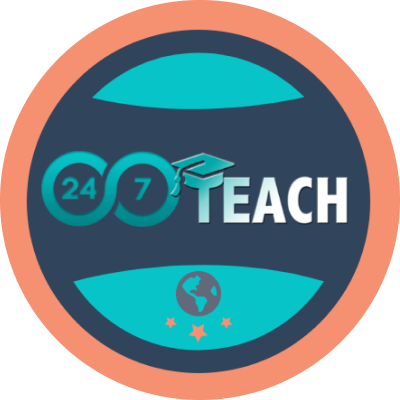Lesson 2: Analyzing Arguments and Managing Sources
Prefer to listen to directions? Use the audio file below.
Lesson 2 Scenario:
Imagine yourself in the following scenario:
You are a student pursuing a career in aviation. You have almost completed your technical training and will soon enter your on-the-job training. However, during a training simulation, you had a miscommunication with your team that could have led to unsafe conditions for the aircraft and passengers. You realize that while you have learned the technical skills necessary for the job, you haven't had much experience with the communication skills required for the position. You speak with your supervisor, who advises that you take an English 101 course hosted by 24/7 Teach to help you become an effective professional communicator.
After your first lesson, you learned that understanding rhetorical situation can help you overcome some communication challenges that might arise on the job. However, you remember that part of the problem during your training simulation was that you struggled to argue your position effectively. You realize that sometimes you have difficulty keeping track of so much information available and making sure that you only use credible information to state your position. You also have trouble making a strong argument. Your next step is to learn what makes an effective, credible argument and how to sort through, evaluate, and manage the sources that you come across.
Lesson 2 - Objectives and Directions:
Objectives: After successfully completing this lesson, you will be able to:
Explain the importance of keeping track of sources and maintaining a working bibliography in academic and professional contexts.
Evaluate the credibility of sources in the field of study or profession.
Explain the characteristics and purpose of an annotated bibliography.
Apply citation principles and guidelines to credit sources appropriately.
Construct and present strong arguments by employing effective persuasive techniques and logical reasoning.
Lesson 2 - Vocabulary:
Click on the button below to preview the essential vocabulary for this lesson. Once you complete the readings, you will need to correctly use at least 3 vocabulary words in your assessment or discussion responses, using the following criteria:
Include 2 vocabulary words in any of your written responses (assessment or discussion)
Include 1 vocabulary word in your audio or video response
In the assessment below, list the 3 vocabulary words you have chosen to use in your responses
Lesson 2 - Presentation and Readings:
Review the following Presentation: (Click here if you wish to download the presentation)
Your required readings for this unit will include chapters from the textbook, Everyone’s an Author, and supplemental annotated bibliographies.
Click on each title below to read the text introductions and to access the links to the reading. Take notes as you read.
-
A persuasive argument is built upon good reasons and solid evidence. In Chapter 11, we will delve into the techniques of presenting a compelling argument and supporting our claims with reliable information. Moreover, we will emphasize the significance of considering multiple points of view, acknowledging differing perspectives, and maintaining an authoritative tone throughout our argument.
By the end of this chapter, you will be equipped with the tools and knowledge to put together well-reasoned and persuasive arguments that connect with diverse audiences.
-
In today's fast-paced digital world, students and professionals like face the challenge of managing information overload and staying organized. Chapter 21 is designed specifically for professionals like you, offering practical strategies to navigate the abundance of information available and maintain a systematic approach to record-keeping.
By the end of this chapter, you will gain invaluable tools and methods to effectively manage information overload, keep track of sources, take purposeful notes, and maintain a working bibliography. These skills will empower you to confidently navigate the professional landscape, ensuring credibility and success in your field. Prepare to enhance your information management abilities and excel in your professional pursuits, armed with the knowledge and strategies to stay organized and on top of the ever-growing sea of information.
-
While organizing your sources is important, the ability to evaluate sources is even more crucial. Chapter 22 explores the art of evaluating sources, equipping you with the necessary skills to determine the worthiness of the information you encounter.
By the end of this chapter, you will learn effective techniques to determine if a source is worth your attention. We will explore strategies for critically analyzing sources, improving your ability to read with a discerning eye.
-
Chapter 23 illustrates the important skill of annotating a bibliography, a valuable tool for researchers to organize and make sense of their sources. In this chapter, we will explore the characteristic features of an annotated bibliography and provide you with practical guidance on how to create effective annotations. We will then examine an annotated bibliography for its characteristic features and the valuable insights into the relevance and usefulness of sources for your research.
-
Plagiarism is a serious offense that can have severe consequences. Chapter 26 provides you with practical techniques to avoid plagiarism by citing and documenting sources effectively. You will learn how to create accurate and consistent citations, as well as understand the various citation styles commonly used in academic writing. By the end of this chapter, you will have a solid understanding of giving credit, avoiding plagiarism, and the importance of meticulous source documentation in your scholarly pursuits.
-
Chapter 27 serves as a reference to MLA Style, providing detailed guidelines on in-text documentation, notes, creating a list of works cited, and formatting a research essay according to MLA conventions. You will use this chapter to evaluate sources for adherence to MLA conventions. You will also use this chapter to create your own MLA citation for this lesson.
Disclaimer: Citations style guides are updated every few years. Therefore, the goal of learning to use citation guidelines is not to memorize guidelines. Students should instead focus on spotting the details of whatever guidelines they are provided, such as capitalization, punctuation, and the order things are placed in.
The citation guidelines in the textbook are not the most current. However, for the purposes of this assignment, we will use the guidelines in this chapter to practice attention to detail.
If you are interested in reviewing the most current citation guidelines, we recommend using https://owl.purdue.edu/.
-
As you review the annotated bibliographies, reflect on the following:
Are the sources credible?
Do the annotations help the reader to understand the relevance to the research topic?
Are the sources cited using in the MLA citation style guidelines provided in the textbook?
Annotated Bibliography 1:
Link: In-Flight Annotated Bibliography (1 page)
Annotated Bibliography 2:
Link: General Aviation in Business Travel Annotated Bibliography (9 pages)
Lesson 2 - Practice 1:
Use what you’ve learned from the chapters in this lesson to complete the following:
Explain which annotated bibliography provides annotations that helps the reader understand the credibility and relevance of the sources.
Create an MLA citation based on the following source from Annotated Bibliography 2 (Refer to Chapter 27 from the textbook)
McGrath, R. N., & Young, S. B. (2002, May). NASA's small
aircraft costs Versus automobile costs and the economic value of traveler time. Technovation,
22(5), 325-336. doi:https://doi.org/10.1016/S0166-4972(01)00078-5
-
Annotated Bibliography 2’s annotations provide summaries of each source in addition to evaluating the credibility and the relevance to the researcher’s topic. Annotated Bibliography 1 provides a brief summary of each source but does not evaluate the credibility or relevance to the researcher’s topic.
Based on section 32. Of Chapter 27, “Article in an online scholarly journal”, the correct citation would be as follows:
McGrath, Robert, & Seth Young.
“NASA's Small Aircraft Costs
Versus Automobile Costs and
the Economic Value of
Traveler Time.” Technovation,
22.5 (2002): 325-336. Web. 30
May 2023.
Changes made include:
Author Name: Include both authors’ full first names. Put the second author’s first name before the last name. (Using the link provided in the original citation, we were able to access the article and get the full names of the authors.)
Article Date: Move the article date after the Volume.Issue. Include only the year in parentheses. Add a colon after the parentheses.
Title: Add quotations to the article title, with the period inside the quotations.
Volume & Issue: Remove the parentheses from the issue number, and separate the volume and issue with a period. Remove the comma after the issue.
Medium: Add the Web for the medium used after the page listing.
Access Date: Add the date you accessed the source in the following order: Day Month Year.
Lesson 2 - Practice 2:
Use what you’ve learned from the chapters in this lesson to complete the following:
Find a credible article related to the aviation industry.
Create an MLA citation for the article.
Include an annotation that summarizes the article and explains why it is credible.
Lesson 2 - Assessment:
Directions:
Click on the button below to submit your responses to the following questions. Write your responses in complete sentences using academic language.
(For question 3, submit an audio recording*. See directions on how to record and submit your audio below.)
You may use the conversation starters found in the lesson directions to support your answers.
Questions:
Name two benefits of completing an annotated bibliography during your research process.
What are the characteristics of patchwriting? Why is patchwriting considered plagiarism?
AUDIO SUBMISSION*: Explain at least 4 of the 8 characteristics of a strong argument
List the 3 vocabulary words you have chosen to use in your assessment or discussion responses.
Participate in our discussion below
↓
Participate in our discussion below ↓
Lesson 2 - Discussion Activity:
Directions:
Post your responses to the questions in the comments section below. (For question 1, submit a video recording*. See directions on how to record and submit your video below.)
Respond to 2 peers. Be specific about what you agree with and what you disagree with. Be respectful in your responses.
Write your responses in complete sentences using academic language.
You may use the conversation starters found in the lesson directions to support your answers.
Discussion Questions:
VIDEO SUBMISSION*: Think about a time when you had to change your mind or adjust your opinion based on new information. How did this experience affect your understanding of the topic and your ability to have a discussion with others? Discuss any strategies that might help you handle differing points of view.
Why do you think people use sources that are not credible? Have you ever used a source that was not credible to support your opinion? If so, what were the reasons you used this source? What steps can you take to ensure that you rely on credible sources when making an argument?
As a professional, have you ever had to argue a point of view? How did you construct your argument and address opposing viewpoints? How did you use sources to support your position? What impact did your argument have on the decision-making process or industry discussions?
























